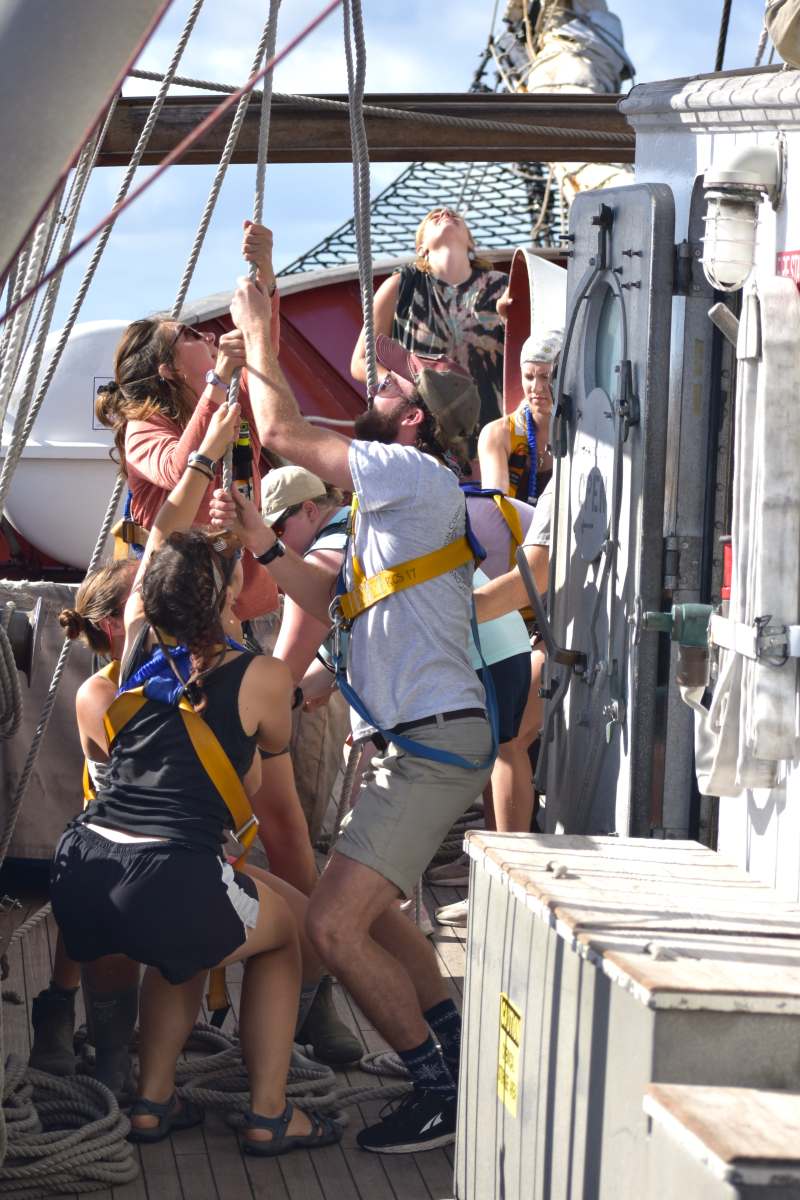Programs Blog
The Work of the Body at Sea

Calvin Lucido, C Watch, Bowdoin College
Ship’s Log
Noon Position
11° 37.8’N x 125° 16.4’W
Ship Heading
182° T
Speed
9kts
Taffrail Log
1547nm
Wind, Weather and Sail Plan
Mostly cloudy with frequent squalls, wind 6kts ENE, motor-sailing under the staysails
Description of Location
1200nm southwest of mainland Mexico
My time at sea has meant embodying my work, literally.
Over the past two years studying ocean science, I’ve worked with plenty of data, but only a little of it has been my own contribution. Usually, it’s a matter of synthesizing or breaking down maps or graphs from organizations with the resources and reputation of NASA and WHOI. Out here, though, more than 700 miles from any land (as of today, I checked), mine are the hands that process the water samples. When I look at my graphs, my fingertips can feel the chill of the water collected more than 800 meters below the surface. And of course, my glutes always remember the work of deployment
Olympics: 10 squats, pushups, or dips for every 100 meters we drop an instrument during our morning science station.
The act of sailing has also been an exercise in embodying my work. There may be deckhands and watch officers, but by number, the students compose the majority of the crew on board. Already, after less than two weeks underway, I’ve grown from not even really knowing that we could sail any direction but downwind to feeling a squall coming just by the way the winds shift.
The muscle memory of setting, striking, and trimming sails is becoming smoother and smoother—and I stress muscle memory because some busy watches on deck feel like a satisfying pull day at the gym! One watch in particular from a few days ago stands out: right as we were entering the Inter-Tropical Convergence Zone, or the Doldrums, we set, struck, or trimmed seven of our eleven sails. I slept well that night.
On the topic of sleep, I’ve found that some of my biggest joys at sea have been the simple, physical things that I take for granted on land. This joy has shown itself as gratitude for the little things, the challenges I’ve chosen to take on, and in culmination this entire incredible experience. I’m grateful for drinking water, which seems almost miraculous far offshore in the Pacific, the largest basin of saltwater on Earth. During training to climb aloft in the rigging, I’m grateful for my body carrying me up to the course yard even though I was feeling shaky. I’m grateful for being able to immerse myself in these relationships, these environments, and this ocean—again literally, remembering jumping off the bowsprit into over 4000 meters of abyssal Pacific.
P.S. from Morgo (happy birthday!):
Mom + Dad, thank you so much for the gifts. Wearing the shorts right now 🙂 Katey, hi hi hi, thanks for the card(s!), simply can’t wait for Tahiti. Miss you tons <3 To Chloe, Olivia got pooped on by a bird today. Laugh out loud.
Calvin Lucido, C Watch, Bowdoin College
Recent Posts from the Ships
- Ocean Classroom 2024-A collaborative high school program with Proctor Academy
- Collaborations and Long-term Commitments: SEA’s Caribbean Reef Program Sets a Course for Coastal Programs that Compliment Shipboard Experiences.
- Sea Education Association students prepare for life underway using state of the art nautical simulation from Wartsila Corporation.
- SEA Writer 2022, Magazines From the Summer SEA Quest Students
- Technology@SEA: Upgrades Allow Insight into Ocean Depths
Programs
- Gap Year
- Ocean Exploration
- High School
- Science at SEA
- SEA Expedition
- SEAScape
- Pre-College
- Proctor Ocean Classroom
- Protecting the Phoenix Islands
- SPICE
- Stanford@SEA
- Undergraduate
- Climate and Society
- Climate Change and Coastal Resilience
- Coral Reef Conservation
- Marine Biodiversity and Conservation
- MBL
- Ocean Exploration: Plastics
- Ocean Policy: Marine Protected Areas
- Oceans and Climate
- Pacific Reef Expedition
- The Global Ocean: Hawai'i
- The Global Ocean: New Zealand